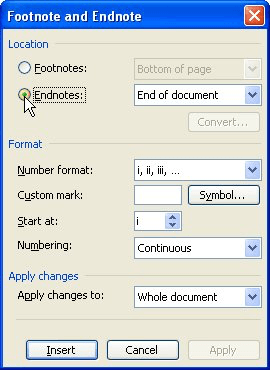Please Note: This article is written for users of the following Microsoft Word versions: 97, 2000, 2002, and 2003. If you are using a later version (Word 2007 or later), this tip may not work for you. For a version of this tip written specifically for later versions of Word, click here: Controlling Endnote Placement.
Word allows you to control where your endnotes appear, if you are using endnotes. You can cause them to appear either at the end of each section in your document or at the end of the document itself. If you don't use sections in your documents, then there is effectively no difference between the two choices. If, however, you use sections to break apart your document into chapters (or some other arbitrary division), then there is a big difference between the two placements.
To control where Word places endnotes in your document, follow these steps if you are using Word 97 or Word 2000:
If you are using a later version of Word, then you should follow these steps instead:

Figure 1. The Footnote and Endnote dialog box.
WordTips is your source for cost-effective Microsoft Word training. (Microsoft Word is the most popular word processing software in the world.) This tip (509) applies to Microsoft Word 97, 2000, 2002, and 2003. You can find a version of this tip for the ribbon interface of Word (Word 2007 and later) here: Controlling Endnote Placement.

The First and Last Word on Word! Bestselling For Dummies author Dan Gookin puts his usual fun and friendly candor back to work to show you how to navigate Word 2019. Spend more time working and less time trying to figure it all out! Check out Word 2019 For Dummies today!
When you have Word calculate how many words there are in a document, it normally doesn't pay attention to text in ...
Discover MoreThe default format for endnote numbers is lowercase Roman numerals. If you want the numbers to use a different format, ...
Discover MoreFootnotes can be an integral part of many documents, particularly those written for a scholarly audience. If those ...
Discover MoreFREE SERVICE: Get tips like this every week in WordTips, a free productivity newsletter. Enter your address and click "Subscribe."
There are currently no comments for this tip. (Be the first to leave your comment—just use the simple form above!)
Got a version of Word that uses the menu interface (Word 97, Word 2000, Word 2002, or Word 2003)? This site is for you! If you use a later version of Word, visit our WordTips site focusing on the ribbon interface.
Visit the WordTips channel on YouTube
FREE SERVICE: Get tips like this every week in WordTips, a free productivity newsletter. Enter your address and click "Subscribe."
Copyright © 2025 Sharon Parq Associates, Inc.
Comments